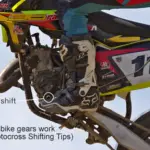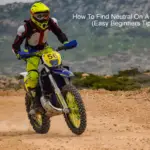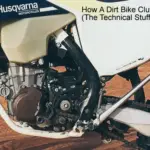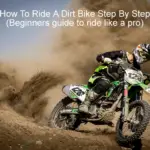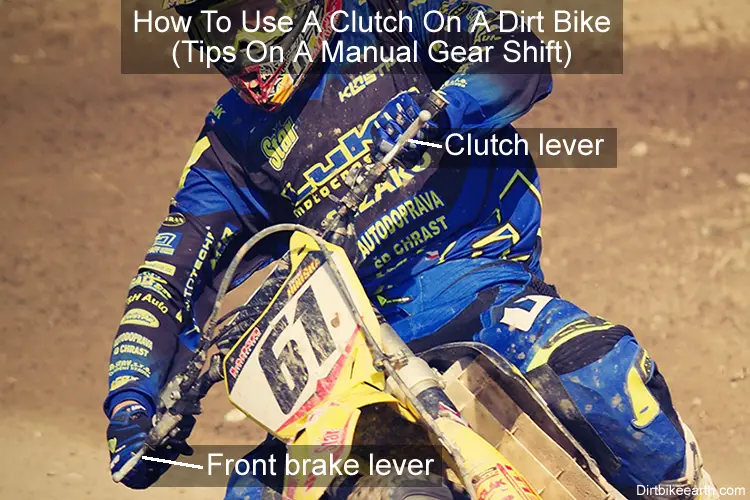
How to ride a dirt bike with a clutch and change gears
This article is for those of you who’ve never used a clutch before, either on a dirt bike or in a car. Most dirt bikes have a clutch and gears. Both of which are explained in this article.
How do you use a clutch on a dirt bike? To ride a dirt bike with a clutch you need to practice with the clutch lever, which should be depressed when you’re stopped and in gear. It’s let it out slowly when setting off and used to change gear when you’re riding. Gear-shifting can be done without the clutch, but it should be used to preserve the gearbox’s life.
What is the purpose of the clutch on a dirt bike?
‘What is a clutch and what does it do‘ is an often asked question. So let’s answer that question first.
A clutch sits between the engine and the gearbox (or transmission) and is used for the purpose of disengaging the power from the engine to the transmission. Where the engine on a dirt bike is what provides the drive or power. And where the gear box (or transmission) transfers the power, usually via a chain and sprockets, to the back wheel.
The clutch sits between the engine’s power and the gearbox (or transmission) to allow you to change gear. So when the clutch is engaged, which is done by pulling on the left lever on the handle bar, the engine is disengaged from the gearbox.
The clutch can be used to bring your dirt bike to a standstill, so that the engine doesn’t stall when it’s in gear. Unlike an automatic gear box, which doesn’t have a clutch lever. With an automatic transmission dirt bike you are able to come to a complete stop without having to worry about engaging a clutch.
So if you’re new to a clutch, this may take a bit of getting used to.
How do you use a clutch on a dirt bike?
Using the clutch on a dirt bike is very easy. The clutch lever is the lever on the left handlebar of your bike.
To use the clutch you need to pull the clutch lever all the way until it touches the handle bar. The clutch lever will have a completely different feel to the opposite front brake lever.
When you pull the right lever to engage the front brake, you’ll notice there’s more resistance to the pull. This is because the brake lever is applying the brake to the front disk. The front brake lever will not (or certainly shouldn’t) be able to be pulled in all the way. The travel of the brake lever should be less than an inch (2.5 cm) or so.
But when you pull the clutch lever, it will feel much easier to pull. The clutch lever will (or should) feel easy to pull all the way in. Try pulling both the left and right levers, one at a time, to see the difference in resistance.
Using the clutch on a dirt bike to pull away
In my article on a beginners guide to dirt bike riding, I suggested using neutral when you start riding. Some recommend to only use the clutch, but for me it’s important for new dirt bike riders to get used to using the clutch and selecting neutral.
To pull away using the clutch, assuming the engine is already running, you first need to pull the clutch all the way in. Then select first gear by pushing down on the gear shift lever with your left foot. This is also located on the left side of the bike. This is the lever just in front of the foot peg.
But before you begin, make sure you have a clear path ahead of you. The last mistake you want to happen is to let out the clutch and collide with an obstacle that’s directly in front of you.
Selecting first gear and pulling away using the clutch on a dirt bike
Put the front of your boot on the gear shift lever and click it down once. You should feel a click, but you should also be able to hear the click too (even if you have your crash helmet on).
Slowly increase the revs of the engine by turning the right handle grip. This is your throttle, which is similar to the foot pedal throttle of a car.
Don’t over rev the engine, as you don’t want to lurch forward when you let the clutch out. Now slowly let the clutch out. Don’t drop the clutch, which is letting go completely and quickly. If you do ‘drop the clutch’ you’ll probably stall the engine or the if the revs are higher, you may lurch forward and fall off the bike.
As the clutch lever reaches what’s known as the bite point, you should feel the bike wanting to go forward. At the bite point, the engine revs will drop a little too. It’s at this point you could increase the revs a bit by twisting the throttle handle towards you.
At the same time, slowly let the clutch out more until the bike moves forward. At this point the clutch should be fully disengaged and you’ll be moving forward in first gear. You can then put both feet onto the foot pegs.
Don’t look down when you’re pulling away. Always look where you are going. Many newbie dirt bike riders tend to look down at the gear shift selector as they pull away, then wonder why they crash into what’s in front of them. Don’t fall into this trap.
How do you shift gears on a dirt bike?
In the above paragraph I explained about how to pull away on your dirt bike using the clutch. This also included using the clutch to select first gear, before pulling away.
But now that you’re moving along in first gear, the next stage is to change gear. The next gear is going to be second gear. This is selected by putting your left boot under the gear shift lever before you pull the clutch in.
When your foot is under the gear lever (remembering not to look down when doing so), you are ready to begin the gear changing sequence. To change gear on a dirt bike there are three controls involved in shifting smoothly. These include the clutch, the gear shift lever and the throttle.
However, when changing down through the gears, there’s and additional control that comes into play, which is braking. But more about that below.
What is the sequence of the controls to change gear on a dirt bike?
Changing up through the gears requires you to let-off on the throttle at the same time as pulling the clutch all the way in. When the clutch is all the way in, click up on the gear shift lever on the left side of the bike. If you’re in first gear, by clicking up you should select second gear.
But be careful to not click the lever too gently, otherwise you’ll end up selecting neutral instead, which lies between first and second gear. There’s a different click when selecting second gear vs neutral. This is something you’ll get used to. But don’t worry if you mistakenly select neutral, as this happens to the best of us bike riders. You’ll soon know when you let out the clutch and pull on the throttle, as the bike will not move forward and the engine will over-rev.
If you happen to select neutral by mistake, don’t worry. Pull the clutch in again after closing off the throttle again, and click the gear shift lever up again. This time you should be in second gear.
Once you feel the click of the gear shift lever into second, let the clutch out and at the same time apply the throttle again. When you are first starting out, don’t open the throttle up too aggressively. Only turn the throttle handle a small amount to increase your speed slightly. As you build confidence and your experience, you’ll be able to go faster then.
Once you’ve increased your speed in second gear, it’s time to change up into third gear, fourth gear and fifth gear (some dirt bikes have sixth gear too). Changing into 3rd, 4th, 5th and so on is done in the same way as you changed into 2nd gear. But changing from 2nd to 3rd and from 3rd to 4th, you don’t have to worry about selecting neutral by mistake.
What about changing down gears on a dirt bike?
When you’re changing down through the gears on a dirt bike, you will need to introduce the break too. I suggest to begin with you get used to only using the rear break, which is the pedal in front of the right foot peg. This is instead of using the front brake which is the lever in front of the right handlebar. As a beginner dirt bike rider, trying to use the throttle at the same time as breaking with the front break can be a bit too much.
It’s also safer to use the rear brake too. Using the front brake on slippery surfaces can be hazardous. The worst outcome can be the front of the bike sliding away from under you. When you use the rear break there’s less chance of crashing or skidding. Plus it’s easier to control a rear wheel skid than it is to control a front wheel skid.
You need to use your brake to slow the bike down between each lower gear change. If you don’t you may lock the rear wheel and skid.
The sequence for changing down through the gears on a dirt bike is as follows:
- Apply the rear brake to slow the bike down.
- Pull the clutch lever in all the way on the left handlebar.
- At the same time as pulling the clutch in, close-off the throttle by turning your right handle grip away from you.
- Using your left foot, click the gear shift lever with the front of your foot, one click down.
- Let out the clutch at the same time as opening the throttle up again, but this time not necessarily as much as you would when you’re going up through the gears and accelerating.
- If you are coming to a stop, you can brake harder and click your way through the gears until you’re in first gear. Then come to a complete standstill, but keep the clutch pulled in. Don’t forget to put your foot out to stop you falling over.
- If you have come to a complete stop, put your foot under the gear shift lever and click it gently up into neutral. You will then be able to let the clutch out and turn your engine off.
Plenty of gear shifting practice is recommended on a dirt bike
At the outset when you’re learning to ride a dirt bike, I suggest you practice gear shifting. Practice going up through the gears and then back down again. Find yourself an area where you can practice this. Either a long straight or a circuit you can go around changing gears.
Use this practice to also keep stopping, selecting neutral, then going back into first gear and pulling away. This practice will help you get used to the clutch’s bite point and changing gears on your dirt bike.
Do you have to press the clutch when braking?
Another question beginner dirt bikers ask is ‘do you have to press the clutch when braking?’
The simple answer is no, you don’t need to press the clutch every time you press the brake. You only need to press the clutch when you are switching gears or when you come to a complete stop. But if you press the brake significantly so that you slow down and you’re going too slow for the selected gear, you may need to change down to a lower gear.
If you are going too slow for the gear selected, you’ll notice the bike will struggle to pull. The ride will become quite jerky and the engine will sound laboured. If this happens, you need to pull the clutch in and change down a gear. Let the clutch out again and if the engine sounds okay, proceed in the new gear selected. If the engine still sounds laboured, you may need to change down another gear or two.
This could happen if you’ve had to brake severely for a corner, for an obstruction or other reason. But you should learn to anticipate what’s happening ahead of you. This way, when you brake, you will already be prepared to change down to the correct gear.
As you build up your experience, you will start to learn the feel and tone of your engine. You will get to know the speeds for each gear too.
What is a semi automatic transmission on a dirt bike?
A semi-automatic transmission dirt bike is a good halfway point between a fully automatic transmission and a fully manual transmission.
But with a semi-automatic transmission dirt bike you don’t have a clutch to worry about, as described above. But you do get the control from shifting gears yourself in the same way as a manual dirt bike. Although you don’t have to worry about the timing of closing the throttle and pulling the clutch in that you need to drive a dirt bike with a clutch.
There are also dirt bikes for kids which have a centrifugal clutch system too. With a centrifugal clutch dirt bike there are no gears to change and no clutch to worry about. They are great for kids to learn to ride on, without having to worry about changing gear and using a clutch.
With a centrifugal transmission dirt bike, the rider only needs to use the throttle and brakes. The automatic gear box takes care of the rest in terms of changing the gears.
Practice using your clutch and changing gear
Before you begin doing more advanced dirt bike skills and dirt bike tricks, like doing a wheelie or jumping your dirt bike, make sure you practice changing gear and using the clutch first.
As already explained above, this is best done in a clear area. Preferably not on a motocross track where there are other riders. Ideally if you can find a straight off-road lane to ride up and down. This will give you plenty of practice at using the clutch and changing gear.
I hope you enjoyed this article about how to ride a dirt bike with a clutch
I’d love to hear from you. Tell us about your adventures of dirt biking in the comments below. Please also share your photos. Either from your cameras or videos from your Gopro’s!
If this article hasn’t answered all of your questions. If you have more questions about dirt biking (or specifically about how to ride a dirt bike with a clutch), please comment below with your questions.
There will also be many more articles about dirt biking for you to read and learn about this fabulous sport and hobby.
Have fun and be safe!
